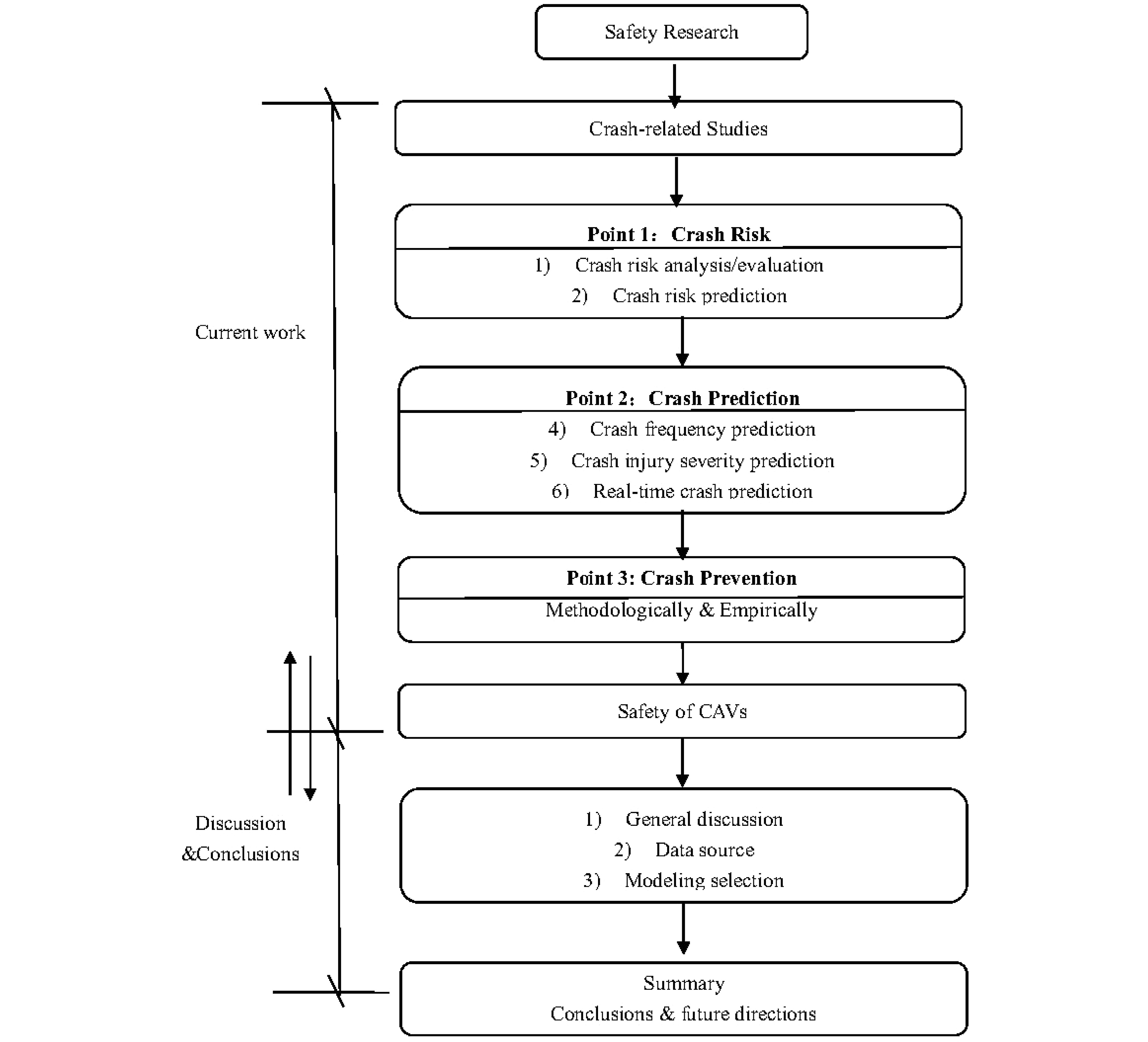-

Figure 1.
Flowchart of this review.
-
Crash procedure Representative studies Methods Strengths and weaknesses Crash Risk Crash risk analysis/evaluation Chen et al. (2012)[6],
Lao et al. (2014)[7],
Yu et al. (2016)[8],
Cunto & Ferreira (2017)[9],
Wu et al. (2018)[10],
Gu et al. (2019)[11]Discrete models (logistic regression, generalized nonlinear model, mixed ordered response, random parameter logistic regression) Significant influencing factors can be clearly revealed while the cause-and-effect relations need to be explained by operators. Theofilatos & Yannis (2014)[12],
Weng et al. (2014)[13],
Weng et al. (2015)[14],
Dingus et al. (2016)[15], Papadimitriou et al. (2019)[16],
Wang et al. (2021)[17],
Adeyemi et al. (2021)[18],
Mahajan et al. (2022)[19]Empirical perspectives (e.g. rear-end collision, drivers merging behavior, naturalistic driving data) Results can be obtained from empirical testing or experiment, whereas the transferability needs to be confirmed. Roshandel et al. (2015)[1],
Papadimitriou & Theofilatos (2017)[20]Meta analysis (e.g. random-effects meta-analysis) Comprehensive but complicated Crash risk prediction Yu & Abdel-Aty (2013)[23],
Yuan & Abdel-Aty (2018)[24],
Yasmin et al. (2018)[25],
Wang et al. (2019)[26],
Guo et al. (2021)[27]Real-time crash risk prediction (SVM, Bayesian approach, random forest) Good results can be obtained by combing the machine learning or data mining with traditional methods, but the prediction accuracy needs to be improved. Bao et al. (2019)[28],
Li et al. (2020)[29],
Wang et al. (2021)[30]Deep neural network (STCL-Net, LSTM-CNN) The prediction accuracy is better whereas the large data and complicated modeling procedure are required. Crash prediction Crash frequency prediction Qin et al. (2004)[31],
Caliendo et al. (2007)[32],
Ma et al. (2008)[33],
Hou et al. (2022)[34]Discrete models (ZIP model, negative binomial, multivariate Poisson-lognormal, random parameter logit model) Significant influencing factors can be clearly revealed while the cause-and-effect relations need to be explained by operators. Hossain & Muromachi (2012)[35],
Sun & Sun (2015)[36],
Dong et al. (2015)[37],
Huang et al (2016)[38],
Tang et al. (2021)[39]Bayesian approach (random multinomial logit, spatial model, hierarchical random parameter Tobit model) The prediction accuracy is improved while the modeling is becoming complicated. Dong et al. (2015)[37],
Huang et al. (2016)[38],
Ambros et al. (2018)[40],
Wu & Tsu (2021)[41]Regional level (SVM with spatial weight, Bayesian spatial model, CNN-GRU) The prediction accuracy is better while the modeling procedure is complicated. Crash injury severity prediction Delen et al. (2017)[42],
Iranitalab & Khattak (2017)[43],
Huang et al. (2018)[44],
Santos et al. (2022)[45]Machine learning methods (SVM, NNC, CART, random forest) The prediction is accuracy is increased whereas the data requirement is large. Li et al. (2019)[46],
Hou et al. (2022)[34]Unobserved heterogeneity (mixed logit model, random parameters logit model) Heterogeneity issue can be addressed while temporal instability is still neglected. Real-time crash prediction Basso et al. (2021)[47],
Thapa et al. (2022)[48],
Man et al. (2022)[49],
Ma et al. (2022)[50],
Li & Abdel-Aty (2022)[51],
Hu et al. (2022)[52]Deep neural network (generative adversarial network, TA-LSTM, FC-LSTM, ConvLSTM) The prediction accuracy is better but the data requirement is improved. Ahmed & Abdel-Aty (2011)[53], Basso et al. (2021)[47],
Li & Abdel-Aty (2022)[51]Real-time data (speed data, trajectory fusion data) Multisource data increase the prediction accuracy but data processing is complicated. Crash prevention Modeling perspective Lee et al. (2003)[54],
Mirzaei et al. (2014)[55]Probabilistic model and logistic regression model Traditional methods can identify the impact factors clearly but the accuracy needs to be improved. Empirical perspective Ker et al. (2005)[56],
El Khoury & Hobeika (2006)[57],
Chen & Qin (2019)[58],
Yue et al. (2020)[59],
Hinnant & Stavrinos (2020)[60],
Gidion et al. (2021)[61],
Peng & Xu (2021)[62]Test or simulation Real scenarios benefit the realization of crash prevention, while the generality needs to be demonstrated. Safety of
CAVsCrash risk Jang et al. (2020)[63] Data from CVs The results were effective in reducing crash potential, but the transferability needs to be examined. Crash prediction Xu et al. (2019)[64],
Sinha et al. (2020)[65]Road testing or simulation The prediction accuracy is better, but the result didn’t achieve the expected safety benefits. Crash prevention Wang et al. (2020)[66],
Wang et al. (2021)[30]Meta-analysis or surrogate safety measures The number of crashes could be reduced whereas the transferability still needs to be demonstrated. Table 1.
Summary of safety literature.
Figures
(1)
Tables
(1)